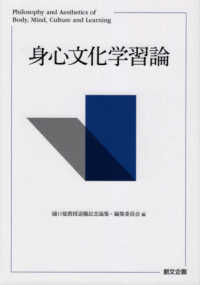- ホーム
- > 洋書
- > 英文書
- > Literary Criticism
Full Description
Greek Tragic Women on Shakespearean Stages argues that ancient Greek plays exerted a powerful and uncharted influence on early modern England's dramatic landscape. Drawing on original research to challenge longstanding assumptions about Greek texts' invisibility, the book shows not only that the plays were more prominent than we have believed, but that early modern readers and audiences responded powerfully to specific plays and themes. The Greek plays most popular in the period were not male-centered dramas such as Sophocles' Oedipus, but tragedies by Euripides that focused on raging bereaved mothers and sacrificial virgin daughters, especially Hecuba and Iphigenia. Because tragedy was firmly linked with its Greek origin in the period's writings, these iconic female figures acquired a privileged status as synecdoches for the tragic theater and its ability to conjure sympathetic emotions in audiences. When Hamlet reflects on the moving power of tragic performance, he turns to the most prominent of these figures: 'What's Hecuba to him, or he to Hecuba/ That he should weep for her?'
Through readings of plays by Shakespeare and his contemporary dramatists, this book argues that newly visible Greek plays, identified with the origins of theatrical performance and represented by passionate female figures, challenged early modern writers to reimagine the affective possibilities of tragedy, comedy, and the emerging genre of tragicomedy.
Contents
Introduction: Recovering Greek Tragic Women
1: Greek Plays in England
2: Imitating the Queen of Troy
3: What's Hecuba to Him?
4: Iphigenia in Illyria: Greek Tragic Women on Comic Stages
5: Bringing back the dead: Shakespeare's Alcestis
6: Parodying Shakespeare's Euripides in Bartholomew Fair
Appendix 1: Pre-1600 Printed Editions of Greek Plays in Greek
Appendix 2: Pre-1600 Printed Editions of Greek Plays in Latin
Appendix 3: Pre-1600 Vernacular Translations of Greek Plays
Appendix 4: Pre-1600 Performances of Greek Plays
Appendix 5: Pre-1600 Vernacular Translations of Seneca's plays
Appendix 6: Pre-1600 Performances of Seneca's plays
Appendix 7: Extant Greek Plays








